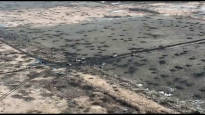From the footage made in Ukraine on the website and on different platforms, you can see that the previously beautiful field landscapes have been shot into holes.
Different videos often show how grenades explode far away from their targets, soldiers or military equipment. We asked an expert what the traces of craters visible in the terrain are and why they are everywhere.
– The majority of them originate from Russian artillery. It is heavy but also imprecise. With us, the fire leader leads the fire to the target, but the Russians don’t do a lot of led fire control, they shoot a lot in large areas, explains the former head of intelligence at the General Staff Pekka Toveri.
In his opinion, the Russians shoot for no reason at all. This is why Toveri characterized the Russian way of war as “cruel, wasteful and stupid.”
The Ukrainian army has been publicly reported to be suffering from a shortage of ammunition. For example, the Minister of Defense in Germany and the President of the Republic in Finland Sauli Niinistö have called for increased production and delivery of ammunition to Ukraine.
Could the tracks in the Ukrainian field landscape also be a sign that ammunition is being directly wasted?
– On the contrary, the Ukrainians shoot 5,000-6,000 rounds a day. They could shoot five or six times more and would like to do so. But since ammunition is limited, the use of fire is saved only for valuable targets, says Toveri.
The Russians, on the other hand, use up to four times more grenades than the Ukrainians.
According to the comrade, the Ukrainians’ hit accuracy is better than the Russians’ and the use of fire is more controlled and accurate.
The long-lasting positional war also has an effect
Another reason for the bumpy terrain is that the war has been going on for so long.
– The war of positions has continued for a long time, and artillery has been fired for years, even tens of thousands of shots in that area. Similar sensations come from the First World War. It’s beginning to resemble the outlook of the First World War.
All this, in turn, tells a part about the nature of war.
The last 20 years have mostly seen wars with less shooting. Fire has been used, but not so massively, because its use has been more precise and often with precision weapons.
Most of the artillery ammunition used now has been traditional fragmentation grenades.
– There is a saying that generals always prepare for the previous war. It is not understood that development develops. This looks a lot like the last war. The war is fought with artillery, infantry and tanks. Artillery and equipment and unfortunately also people are used up a lot, says Toveri.
Wasteful warfare leads to a reduction in the use of artillery, because ammunition has to be rationed – and eventually to an ammunition shortage.
The Russians also had to reduce the use of artillery
– Today, the Russians often fire 20,000 rounds a day, which is a third of the number of last summer. Pre-war warehouses have mostly been used, says Toveri.
Although the Russians have increased their ammunition production, it takes the Russian defense industry approximately half a year to produce the equivalent amount.
Comrade believes that with the current consumption at the end of the year, Russia will have considerable challenges in terms of the sufficiency of ammunition.
But the sale of ammunition seems to have surprised the Western countries as well?
– This indicates that during peacetime, ammunition has not been produced in such a large amount, because there has not been seen to be a need for them. Now many western countries have handed over their stocks to Ukraine, and stocks are starting to run out, Toveri says.
The Ukrainians use roughly the same amount of ammunition as the United States can produce in a year.
According to Tover’s calculation, the million grenades promised by the EU are enough for about half a year.
The Americans are now trying to increase ammunition production sixfold. According to a colleague’s assessment, it would start to be sufficient for the needs.
The interviewee is a candidate in the parliamentary elections.
